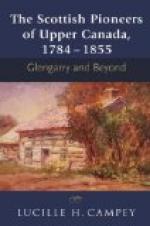[Footnote 4: The Recollet (properly Recollect) friars were a strict branch of the Franciscan order that were sometimes called the Observantines. They were also known as “Recollects” (pronounced in French recollet) because they were required to be constantly keeping guard over their thoughts. This development of the Franciscan order of preaching missionary friars was originally a Spanish one, founded early in the sixteenth century, and becoming well established in the Spanish Netherlands. Many of them were Flemings or Walloons.]
In 1626 the Jesuit order supplanted the Recollets, and commenced a campaign both of Christian propaganda and of geographical exploration which has scarcely finished in the Canada of to-day.
In 1627 the war between the Iroquois Confederacy and the Huron and Algonkin tribes recommenced, and this, together with the British capture of Quebec and other portions of Canada, put a stop for several years to the work of exploration. This was not resumed on an advanced scale till 1634, when Champlain, unable himself, from failing health, to carry out his original commission of seeking a direct passage to China and India across the North-American continent, dispatched a Norman Frenchman named JEAN NICOLLET to find a way to the Western Sea. Nicollet, as a very young man, had lived for years amongst the Amerindian tribes, especially amongst the Nipissings near the lake of that name. Being charged, amongst other things, with the task of making peace between the Hurons and the tribes dwelling to the west of the great lakes, Nicollet discovered Lake Michigan. He was so convinced of the possibility of arriving at the Pacific Ocean, and thence making his way to China, that in the luggage which he carried in his birch-bark canoe was a dress of ceremony made of Chinese damask silk embroidered richly with birds and flowers. He was on his way to discover the Winnebago Indians, or “Men of the Sea”, of whom Champlain had heard from the Hurons, with whom they were at war. But the great water from which they derived their name was not in this instance a sea, but the Mississippi River. The Winnebago Indians were totally distinct from the Algonkins or the Iroquois, and belonged to the Dakota stock, from which the great Siou confederation[5] was also derived.
[Footnote 5: See p. 160.]




